

Rules of Differentiation of Functions in Calculus. The basic rules of Differentiation of functions in calculus are presented along with several examples .
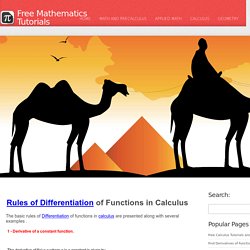
Home Page -- HTML5 Math Applets for Mobile Learning -- Math Formulas for Mobile Learning -- Algebra Questions -- Math Worksheets -- Free Compass Math tests PracticeFree Practice for SAT, ACT Math tests -- GRE practice -- GMAT practicePrecalculus Tutorials -- Precalculus Questions and Problems -- Precalculus Applets -- Equations, Systems and Inequalities -- Online Calculators -- Graphing -- Trigonometry -- Trigonometry Worsheets -- Geometry Tutorials -- Geometry Calculators -- Geometry Worksheets -- Calculus Tutorials -- Calculus Questions -- Calculus Worksheets -- Applied Math -- Antennas -- Math Software -- Elementary StatisticsHigh School Math -- Middle School Math -- Primary MathMath Videos From Analyzemath Author - e-mail.
Derivative. Physics. Surfaces. Vectors. Matrices. Ti 89. Integral. Series/Sequences. More. Introduction.html. From Wolfram MathWorld. (793,#29) The length and width of a rectangle are measured as 30 cm. (793,#29) The length and width of a rectangle are measured as 30 cm and 24 cm, respectively, with an error in measurement of at most 0.1 cm in each.
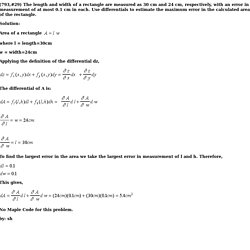
Math 21a Midterm I Review. Lab3-.html. Functions of two variables Let us start with a simple function -- the distance between the point (x,y) and the origin.
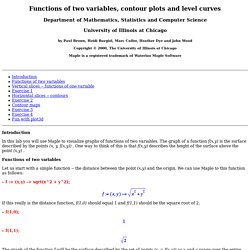
We can use Maple to this function as follows: > f := (x,y) -> sqrt(x^2 + y^2); If this really is the distance function, f(1,0) should equal 1 and f(1,1) should be the square root of 2. > f(1,0); > f(1,1); The graph of the function f will be the surface described by the set of points (x, y, f(x,y)) as x and y range over the entire plane. We can use Maple's 3D graphics to plot the graph of f. > with(plots): > plot3d(f(x,y), x=-2..2, y=-2..2, axes=BOX, shading=ZHUE, scaling=constrained); By "dragging" this plot with the left mouse button you can look at it from different viewpoints. Equations of Lines and Planes. Lines in Three Dimensions A line is determined by a point and a direction.
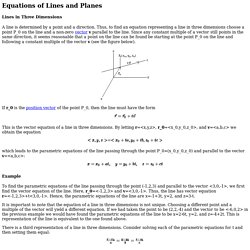
Thus, to find an equation representing a line in three dimensions choose a point P_0 on the line and a non-zero vector v parallel to the line. Since any constant multiple of a vector still points in the same direction, it seems reasonable that a point on the line can be found be starting at the point P_0 on the line and following a constant multiple of the vector v (see the figure below). If r_0 is the position vector of the point P_0, then the line must have the form This is the vector equation of a line in three dimensions.
ProblemsSection9.5.html. Everything Maths and Science. Decide how to tackle the problem The first thing we must realise is that the order that we add the vectors does not matter.
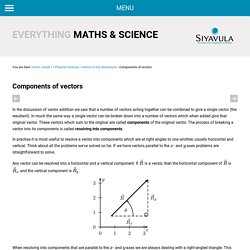
Therefore, we can work through the vectors to be added in any order. CIRCULAR MOTION,2D motion,mechanics revision notes from A-level Maths Tutor. Summary of equations Describing the circle - position vector R i & j are unit vectors along the x and y-axis respectively.
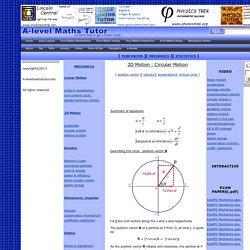
The position vector R of a particle at P from O, at time t, is given by: As the position vector R rotates anti-clockwise, the particle at P traces out a circle of radius r . back to top. Translations. Translations are often informally called “slides”.
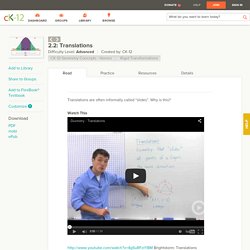
Why is this? Guidance A translation is one example of a rigid transformation . Presentation1 yash maths. Quick Reference Guide. Quadcopter Math and Modelling: May 2014. The center of mass is the unique point at the center of a distribution of mass in space that has the property that the weighted position vectors relative to this point sum to zero.
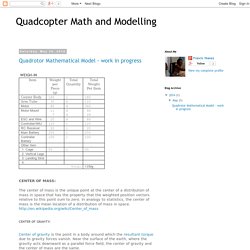
In analogy to statistics, the center of mass is the mean location of a distribution of mass in space. Center of gravity is the point in a body around which the resultant torque due to gravity forces vanish. Point, Line, Plane. In what follows are various notes and algorithms dealing with points, lines, and planes.

Written by Paul Bourke October 1988 This note describes the technique and gives the solution to finding the shortest distance from a point to a line or line segment. The equation of a line defined through two points P1 (x1,y1) and P2 (x2,y2) is P = P1 + u (P2 - P1) The point P3 (x3,y3) is closest to the line at the tangent to the line which passes through P3, that is, the dot product of the tangent and line is 0, thus. How to Plot Points in Three Dimensions: 8 Steps. Index.
Light The Fire - Lesson List. BCCalculus - Parametric Equations. Parametric equations are a method of defining a function using parameters.
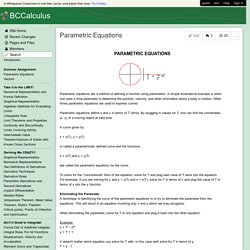
A simple kinematical example is when one uses a time parameter to determine the position, velocity, and other information about a body in motion. Often times parametric equations are used to express curves. Math.sci.ccny.cuny. Volume of Right Circular Cone - ProofWiki. Calculus, by Smith and Minton. Surface Area Figure 5.38 Surface of revolution. The only problem with this is that we don't know Figure 5.39a Right circular cone. Figure 5.39b Flattened cone. Figure 5.40 Frustum of a cone. 6+ integral [a,x] (f(t)/(t^2))dt = 2sqrt(x) for x>0. How do you find function f and number a? VisualCalc. Geometry I WS 12. Cross-ratio of lines through a point (again). Claim. The map which maps a point g∗∈p∗ to the intersection point of g∩ℓ is a projective map. Proof. Let {b1,b2,b3} be a basis of R3, such that P=[b1] and ℓ=P(span{b2,b3}). This yields a dual basis {b∗1,b∗2,b∗3} of R3 with b∗i(bj)=δij.
Let g∗=[sb∗2+tb∗3]∈p∗ be a point on the line P∗. 0=(sb∗2+tb∗3)(xb2+yb3)=sx+ty. Solving this for x and y yields the following point of intersection Q=g∩ℓ=[−tb2+sb3], so the map P∗→ℓ is given by g∩ℓ=[(0−110)(st)] for g=[sb∗2+tb∗3]. Archimedes and the area of an ellipse: an intuitive approach. Tangent Line: Definition & Equation. Free online math calculators and solvers. Here you can find variety of powerful online math calculators and solvers for problems including polynomial equations, rational expressions, systems of equations, vectors, matrices, complex numbers, analytic geometry, statistics... These calculators can help you with basic and advanced problems in high school and college math. All of them are capable of performing exact computations. Also, almost every of them will generate a step by step explanation. All calculators have simple and easy-to-use interface. 1. Arithmetic Operations With Polynomials - This calculator performs arithmetic operations with polynomials i.e., addition, subtraction, multiplication and division.
Synthetic Division Calculator - Divide polynomials, determine remainder, check if x-c is factor. Expand and Simplify Polynomials - This calculator will expand and simplify any polynomial. Polynomial Roots Calculator - finds the roots of any polynomial. 2. Or . 3. Or even 4. And 5. 6. 6.1 Triangles 6.2 Quadrilaterals 6.3 Circle. Numerical integration. Some functions cannot be integrated analytically (on paper). The integrals above cannot be solved analytically, that is, on paper. They can't be expressed exactly as some combination of elementary functions. Another way to say it is that for each of those integrals above (and many others), there is no combination of trigonometric, polynomial, root, exponential or logarithmic functions that can be found which, when differentiated, give back the integrand you're working with.
Math%20125%20notes%20section%201.5.pdf. Polynomial functions and derivative (3): Cubic functions. The derivative of a function at a point can be defined as the instantaneous rate of change or as the slope of the tangent line to the graph of the function at this point. We can say that this slope of the tangent of a function at a point is the slope of the function. The slope of a function will, in general, depend on x.
Then, starting from a function we can get a new function, the derivative function of the original function. The process of finding the derivative of a function is called differentiation. The value of the derivative function for any value x is the slope of the original function at x. Related Rate Problems. Mathway.
Balloon Calculus: standard integrals, derivatives and methods. Steps Into Calculus by Learning Enhancement Team on Prezi. Calculus. Calculus BetterExplained. 5.1 Maxima and Minima. World Web Math: Calculus Summary. Calculus 1550, section 5, Fall 2004. Week 5. Calculus-Help.com: Survive calculus class! - Tutorials for the Calculus Phobe. Calculus - Math Learning Guides. Calculus - Boyle's Law Related Rates question. Calculus Problem (involes critical numbers) Discontinuities in Functions and Graphs Video - Lesson and Example. Discontinuities. Visual Calculus - Piecewise Defined Functions. From Wolfram MathWorld. Differentiation. Calculus I Notes, Section 3-1. Math - Calculus. Limits Videos & Lessons. MATH_calculus4 - What is Calculus? Websites for Teaching Calculus. Calculus early transcendental functions (3rd edition) robert smith … Calculus 1550, section 5, Fall 2004. Week 2. CALCULUS PROBLEM AND SOLUTION DATABASE.
Ebookfree24.info calculus_ single variable (5th edition) (2) Calculus calculus cheat-sheet_all.